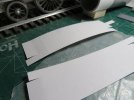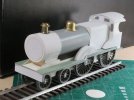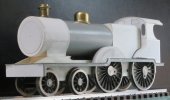Tim Watson
Western Thunderer
Fascinating stuff Michael. I recollect a builder, I think from Central Europe, making outstanding gauge 1 models from card. His SNCF 241P was amazing, but I can’t find a link anywhere.
Tim
Tim
mirmic was the builder: "DUCHESS OF SUTHERLAND" of cardboardI too recall that, I think there might have been something on RMWeb.

My friend who I was helping with his Corel program for his laser cutter is successfully cutting 6mm acrylic sheet for archbar type bogie frames and .020 styrene.Whilst plasticard doe not, Card-card does lend itself to lasers...
My friend who I was helping with his Corel program for his laser cutter is successfully cutting 6mm acrylic sheet for archbar type bogie frames and .020 styrene.
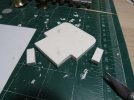
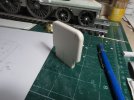 Next a 1/2 inch Forstner bit to cut the fire hole I strengthen the layers as the cutter went through each layer, by removing the piece from the mill/drill treated the next lower layer and so on till I cut all the way through The piece is like a bit of 3/16 Styrene sheet. even sounds like a bit of plastic when dropped onto the table.
Next a 1/2 inch Forstner bit to cut the fire hole I strengthen the layers as the cutter went through each layer, by removing the piece from the mill/drill treated the next lower layer and so on till I cut all the way through The piece is like a bit of 3/16 Styrene sheet. even sounds like a bit of plastic when dropped onto the table.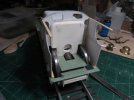 Now to wait for the books to arrive to plot all the holes for the valves and piping. Then to finish boxing in the wheels.
Now to wait for the books to arrive to plot all the holes for the valves and piping. Then to finish boxing in the wheels.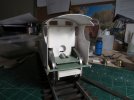
Jon The smallest section (top circle) 1 piece archival mat board, was shaped first and then treated along the edge with the CA clue and then sanded around the edge to form the small radius, the back side of the domed circle was also sanded to create a small flat so that it can be glued to the thinner middle circle 2 layers of printable card stock, that was also treated with the CA around the edge so that the tiny radius could be sanded.Michael
Was the glue still wet when you worked the smokebox door?
Jon
Pete thanks for the tip it worked beautifully the difficult part was finding the right cup to use as a mold, I did not want to turn one up as that would is some way be defeating the purpose. The way I proceeded was very slowly being gentle so not to crease the card.Spot on with that smokebox door Michael! I am so relieved that it worked, as I was beginning to panic after mentioning the spoon! I was afraid that you might ask for more information - and it was, after all, fifty years ago that I did mine as an experiment, so for the life of me could not remember quite how I actually managed it!
Pete.
Simon thank you, it is an interesting challenge for sure, given our modern glues I think has moved the need for us as far as what can be acheived with this humble material. The backhead has proven to me what can be done with some very simple tools. Knife, ruler, files, sandpaper, and Glue. I am hoping the books from Wild Swan get here before Christmas but no matter I will enjoy them enyway.Such a joy to see all this lovely handwork, it is going to look really good!
